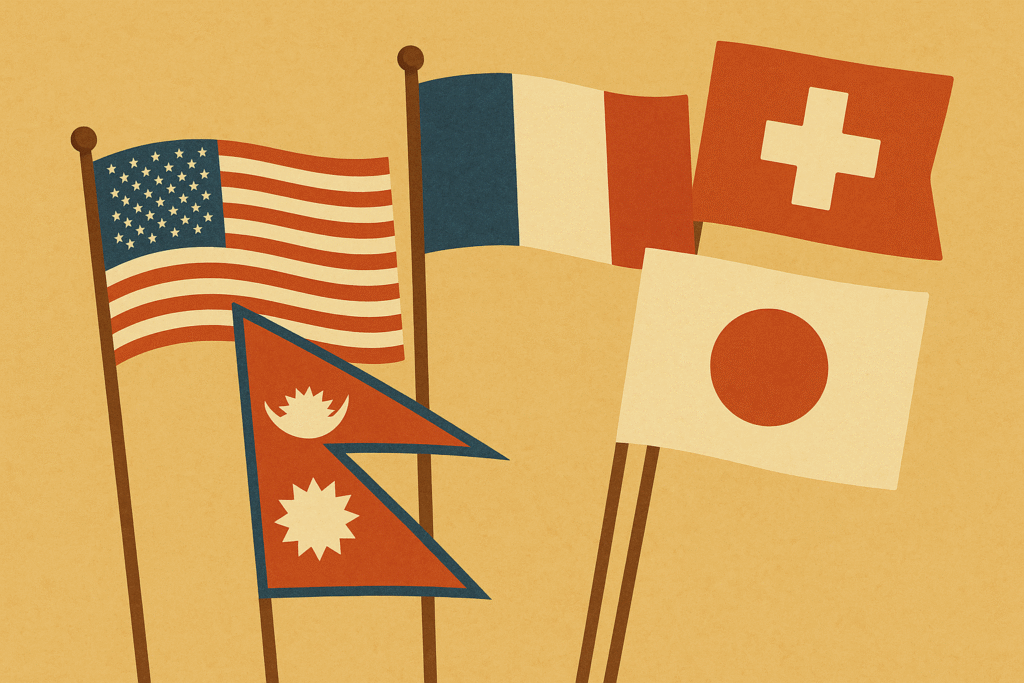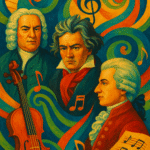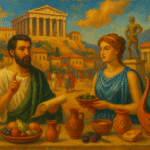Imagine a world without the common sight of rectangular flags. Difficult, isn’t it? Yet, high in the Himalayas, Nepal flies a pennant that defies this global norm. This peculiarity urges us to explore why most flags adopt the rectangular shape and to delve into the stories embedded in their designs and colors. Join me on this captivating journey into the enchanting world of flag symbolism and design, where each emblem whispers tales of national identity and culture.
The Common Shape of Flags: A Historical Perspective
Historical Influence on Flag Design
The rectangular shape of most national flags isn’t a mere coincidence but rather a product of historical evolution. Flags, as we know them today, are deeply rooted in the cultures of ancient civilizations, with traces found in Egypt and Rome. They were initially used for military purposes, as their shapes and symbols conveyed strategic messages across battlefields. As colonial powers expanded, they took their symbols and designs with them, imprinting their traditions on the flags of their colonies. This colonial legacy greatly influenced contemporary flag designs worldwide, promoting adherence to the elegant simplicity of rectangles.
Symbol of Unity: Why Rectangles?
The rectangle symbolizes uniformity and consistency. Its straightforward form ensures that flags can be easily reproduced and universally recognized. A rectangular design allows for efficient manufacturing and raises fewer challenges in terms of proportion and symmetry. This geometric form accommodates symmetrical patterns and symbols and emerges as a potent, unifying emblem – a quality immensely important for national identity. Rectangles, by their very nature, emphasize coherence and integration, aligning with the ideals that national flags often strive to represent.
The Flag of Nepal: A Unique Journey
What Makes Nepal’s Flag Different?
Nepal’s flag stands alone, its shape resembling a double-pennant, unlike any other national flag in the world. This unique design is laden with cultural symbolism. Comprised of two stacked triangles, the flag is a testament to Nepal’s religious and historical narratives. The upper triangle showcases a stylized moon, while the lower one displays a sun, symbolizing the nation’s hope that Nepal will remain as everlasting as these celestial bodies. The shape itself reflects the Himalayan mountains, synonymous with the nation’s geographical identity, emphasizing Nepal’s distinctiveness and autonomy.
Myths and Facts About Nepal’s Unique Shape
Numerous myths surround Nepal’s flag, one being the belief that its triangular form brings good luck. Some also speculate a historical link to fanion traditions used in Nepali military units. Contrary to some misconceptions, Nepal’s choice to maintain this distinctive shape is not merely aesthetic eccentricity but stems from a rich tradition and heritage that refuses homogenization.
Flags and Their Meanings: What Do Designs Convey?
Symbolism Behind Flag Colors
Colors are not merely decorative but imbued with profound meanings across cultures. For instance, red often symbolizes valor and bravery, seen in flags like that of the United States and China. Green signifies hope and fertility, evident in Nigeria’s flag, while blue often represents peace and stability, as depicted in the flag of France. These hues uniquely articulate cultural narratives and shared ideals, enriching national flags’ visual and symbolic allure.
Shapes and Patterns
Shapes and patterns on flags carry ancient and modern significance, transcending mere design. The cross on the Scandinavian countries’ flags like Sweden symbolizes Christian heritage, while stars, seen on the American and Chinese flags, evoke aspirations. Patterns like stripes and fields, found on Germany and Japan’s flags respectively, reinforce the nation’s historical and cultural ethos. Such geometric elements are constitutive to the narrative fabric of each nation’s identity.
Rectangular Flags: A Global Standard
Why Are Most Flags Rectangular?
The predominance of rectangular flags can be attributed to their practicality in production and versatility. This shape ensures that flags wave rhythmically in the wind, providing an eye-catching presentation that remains stable even in unfurling conditions. Rectangles are economical to reproduce, facilitating consistency in ratio and design, which is indispensable for standardized national symbols.
The Evolution of Flag Shapes
The evolution of flag shapes reveals an intriguing journey from ancient banners to modern emblems. Initially, shapes were dictated by practical needs on the battlefield; however, over time, as societies grew more interconnected, so did the demands for uniformity and recognition in international arenas. Thus, the rectangle emerged as the universal canvas for expressing national identity, withstanding adaptations and evolving geopolitical contexts.
Cultural Significance of National Flags
Flags as Historical Narratives
Flags serve as dynamic chronicles of nations, embodying histories and aspirations. The Union Jack echoes centuries of British maritime prowess, weaving tales of its empire, while Ethiopia’s flag tells of its resilience and struggle against colonization. Each flag encapsulates historical narratives, preserving national memory within the folds of fabric through meticulously chosen symbols.
Flags Reflecting Identity
Beyond their striking designs, flags are declarations of identity. The maple leaf on Canada’s flag champions nature’s connectivity, mirroring its citizens’ ties to the land. The vertical bands on Italy’s flag tell a tale of regeneration post-unification. National flags artistically represent unique identities, offering sinews of connection to traditions amid global anonymity.
Other Unique Flag Shapes in the World
Beyond Nepal: Other Odd Shapes
While Nepal’s triangles hold distinct prominence, other flags diverge from the standard. Switzerland’s flag stands unique with its square shape, an homage to biblical psalms and tradition. Similarly, Ohio, a U.S. state, boasts a burgee shape, rich in historical symbolism reflective of its early statehood. These exceptions enrich the tapestry of world flags, contributing diverse narratives.
Cultural Influences in Flag Designs
International influences yield varied and imaginative designs worldwide. Flags draw elements from historical nuances and cultural exchanges – Mahatma Gandhi’s spinning wheel influencing India’s flag, or the French Tricolor inspiring revolutions across Europe. These influences continuously shape and refine the art of flag design.
The Future of Flag Design
Innovation in Flag Designs
Flag design is no longer anchored solely in tradition; modern innovations propel it into digital realms. Cities like Amsterdam have experimented with designs symbolizing urban identities, showcasing flags on digital platforms. The blending of technology and design illustrate the new frontier, preserving tradition while experimenting with new creative avenues.
Engaging the Future: Flags and Society
Community involvement heralds a promising future for flag designs. Collaborative efforts enabled by social media and digital platforms catalyze citizens’ engagement in redesigning city and town flags, making the process a shared cultural endeavor. This democratization of flag design fosters participatory growth, reflecting society’s evolving spirit and unity.
Conclusion: Reflecting Culture Through Rectangles
The narrative of national flags is one of complexity, teeming with symbolism and meaning. Although many adhere to the rectangular convention, their stories diverge in depth and significance, capturing cultural heritage and aspirations. As the world advances, so too does the rich tapestry of flag design, echoing the past while engaging with future possibilities.
FAQs About National Flags and Their Designs
1. Why do most national flags look alike?
The rectangular shape provides practical advantages such as ease of production and consistency. This makes them universally recognizable and facilitates uniformity in international settings.
2. What is the significance of flag colors?
Colors on flags carry profound meanings. For instance, red often symbolizes bravery, green represents fertility, blue signifies peace, and white denotes purity. Each color choice is deeply rooted in cultural significance.
3. Are there other countries with unusual flag shapes?
Yes, besides Nepal, countries like Switzerland have square flags, while Ohio in the U.S. features a burgee shape, highlighting a diversity of design that extends beyond the common rectangle.
4. How has technology influenced flag designs?
Technology has introduced digital innovations, allowing for dynamic designs and community involvement in flag creation, which enriches how flags are perceived and utilized in contemporary society.
5. What historical events shaped modern flags?
Several pivotal historical events, including wars and revolutions, have left indelible marks on flag designs. Colonial legacies and cultural renaissance movements have also shaped flag artistry.
By delving into the world of flags, we uncover a domain rich in history and cultural significance. Whether in their rectangular form or more unique shapes, flags continue to tell the vibrant stories of nations worldwide. Feel free to explore this fascinating topic further or engage with local flag redesign initiatives for a firsthand experience of evolving national symbols.


